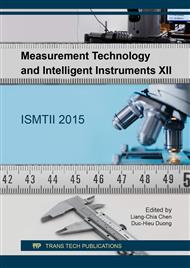p.67
p.73
p.79
p.85
p.95
p.102
p.108
p.114
p.120
A Multi-Segments Stitching Method for Profile Measurement of Large Scale Aspheric Surface within Submicrometer Accuracy
Abstract:
A multi-segments stitching method is proposed to obtain two-dimensional profile of large scale aspheric components during grinding process. We firstly analyze the corresponding relation between surface features of aspherics and measurement range of profilometer. According to multi-body system theory and slope difference, a mathematical model of multi-segments stitching method is constructed. Further, the multi-segments stitching errors based on 400 mm aspheric profile are simulated with different translation amounts, rotation angles, translation errors as well as rotation errors. The simulation results indicate that the translation error is the key factor for measuring accuracy of the multi-segments stitching method. In addition, the standard deviations of multi-segments stitching errors are between 0.2 μm and 0.4 μm as the four factors are set to the proper values. To verify the simulation analysis results, an experimental setup, including Talysurf PGI 1240 and fixture, is applied to detect a 150 mm profile line on the aspheric surface. The experiment results show that the standard deviations of multi-segments stitching errors are almost within 1 μm when the rotation angle is under 7° and the translation amount is under 11 mm. The multi-segments stitching method can employ a small-range profilometer to achieve measurement of large scale aspheric surfaces with submicrometer accuracy.
Info:
Periodical:
Pages:
95-101
Citation:
Online since:
September 2017
Authors:
Price:
Сopyright:
© 2017 Trans Tech Publications Ltd. All Rights Reserved
Share:
Citation:


